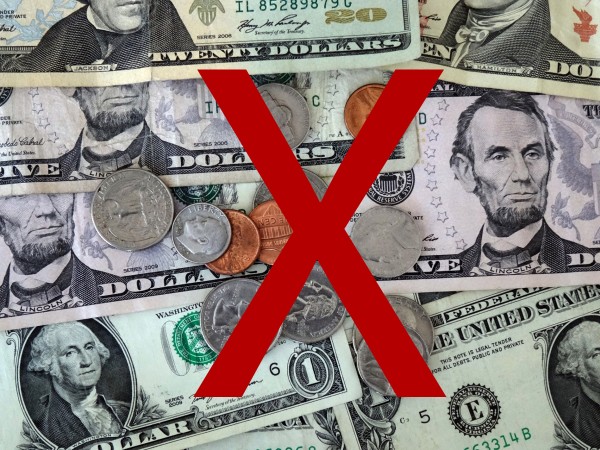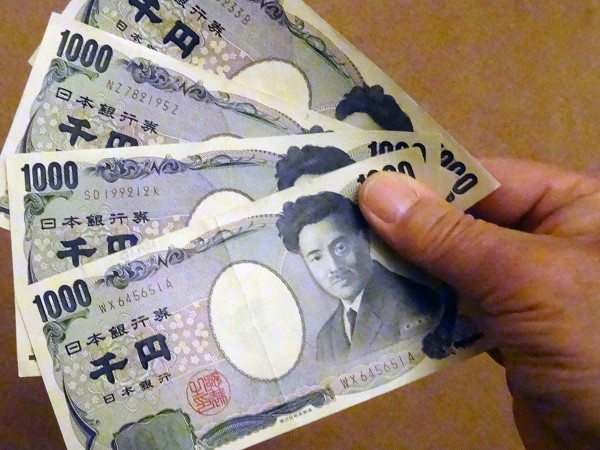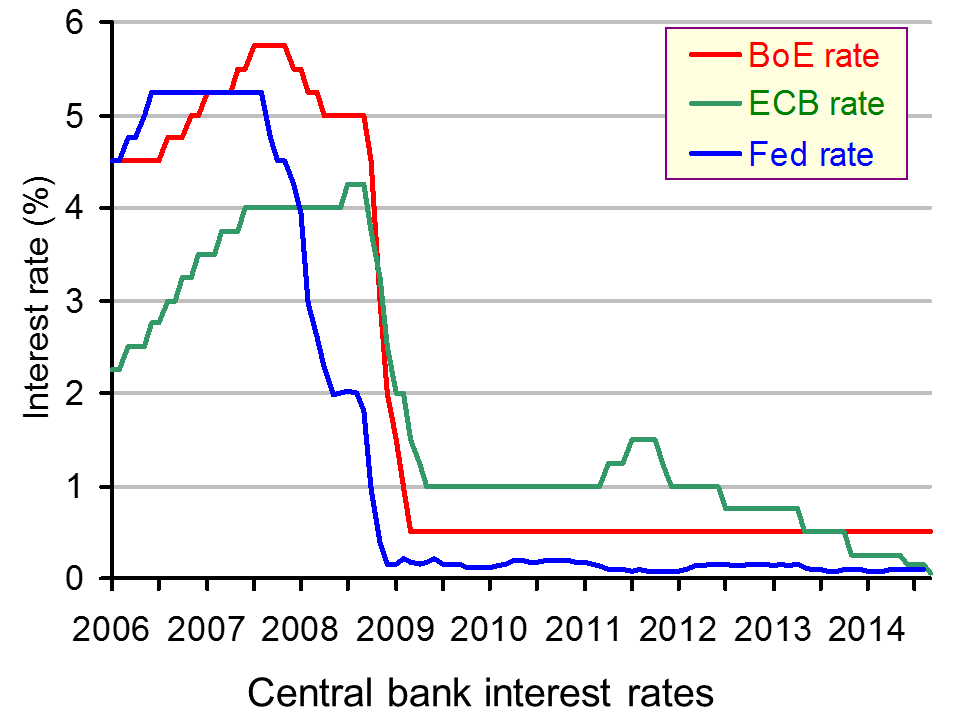 Following the recession of 2008/9, the UK has engaged in four rounds of quantitative easing (QE) – the process whereby the central bank increases the money supply by purchasing government bonds, and possibly other assets, on the open market from various institutions. The final round was announced in July 2012, bringing the total assets purchased to £375bn. As yet, however, there are no plans for quantitative tightening – the process of the Bank of England selling some of these assets, thereby reducing money supply.
Following the recession of 2008/9, the UK has engaged in four rounds of quantitative easing (QE) – the process whereby the central bank increases the money supply by purchasing government bonds, and possibly other assets, on the open market from various institutions. The final round was announced in July 2012, bringing the total assets purchased to £375bn. As yet, however, there are no plans for quantitative tightening – the process of the Bank of England selling some of these assets, thereby reducing money supply.
The aim of QE has been to stimulate aggregate demand. Critics claim, however, that the effect on spending has been limited, since the money has not gone directly to consumers but rather to the institutions selling the assets, who have used much of the money to buy shares, bonds and other assets. Nevertheless, with banks having to strengthen their capital base following the financial crisis, QE has helped then to achieve this without having to make even bigger reductions in lending.
The Bank of England now reckons that the recovery is sufficiently established and there is, therefore, no need for further QE.
 This is also the judgement of the Federal Reserve about the US economy, which experienced annual growth of 3.5% in the third quarter of 2014. The IMF predicts that US growth will be around 3% for the next three years.
This is also the judgement of the Federal Reserve about the US economy, which experienced annual growth of 3.5% in the third quarter of 2014. The IMF predicts that US growth will be around 3% for the next three years.
The Fed has had three rounds of QE since the financial crisis, but in October 2014 called an end to the process. Since the start of this year, it has been gradually reducing the amount it injects each month from $85bn to $15bn. The total bond purchases over the past five years have been some $3.6tn, bringing the Fed’s balance sheet to nearly $4.5tn.
 But as QE comes to an end in the USA, Japan is expanding its programme. On 31 October, the Bank of Japan announced that it would increase its asset purchases from ¥60-70tn per year to ¥80tn (£440bn). The Japanese government and central bank are determined to boost economic growth in Japan and escape the two decades of deflation and stagnation. The Tokyo stock market rose by some 8% in the week following the announcement and the yen fell by more than 5% against the dollar.
But as QE comes to an end in the USA, Japan is expanding its programme. On 31 October, the Bank of Japan announced that it would increase its asset purchases from ¥60-70tn per year to ¥80tn (£440bn). The Japanese government and central bank are determined to boost economic growth in Japan and escape the two decades of deflation and stagnation. The Tokyo stock market rose by some 8% in the week following the announcement and the yen fell by more than 5% against the dollar.
And the European Central Bank, which has not used full QE up to now, looks as if it is moving in that direction.  In October, it began a programme of buying asset-backed securities (ABSs) and covered bonds (CBs). These are both private-sector securities: ABSs are claims against non-financial companies in the eurozone and CBs are issued by eurozone banks and other financial institutions.
In October, it began a programme of buying asset-backed securities (ABSs) and covered bonds (CBs). These are both private-sector securities: ABSs are claims against non-financial companies in the eurozone and CBs are issued by eurozone banks and other financial institutions.
It now looks as if the ECB might take the final step of purchasing government bonds. This is probably what is implied by ECB President Mario Draghi’s statement after the 6 November meeting of the ECB that the ground was being prepared for “further measures to be implemented, if needed”.
But has QE been as successful as its proponents would claim? Is it the solution now to a languishing eurozone economy? The following articles look at these questions.
Fed calls time on QE in the US – charts and analysis The Guardian, Angela Monaghan (29/10/14)
Quantitative easing: giving cash to the public would have been more effective The Guardian, Larry Elliott (29/10/14)
End of QE is whimper not bang BBC News, Robert Peston (29/10/14)
Federal Reserve ends QE The Telegraph, Katherine Rushton (29/10/14)
Bank of Japan to inject 80 trillion yen into its economy The Guardian, Angela Monaghan and Graeme Wearden (31/10/14)
Every man for himself The Economist, Buttonwood column (8/11/14)
Why Japan Surprised the World with its Quantitative Easing Announcement Townhall, Nicholas Vardy (7/11/14)
Bank of Japan QE “Treat” Is a Massive Global Trick Money Morning, Shah Gilani (31/10/14)
ECB stimulus may lack desired scale, QE an option – sources Reuters, Paul Carrel and John O’Donnell (27/10/14)
ECB door remains open to quantitative easing despite doubts over impact Reuters, Eva Taylor and Paul Taylor (9/11/14)
ECB could pump €1tn into eurozone in fresh round of quantitative easing The Guardian,
Angela Monaghan and Phillip Inman (6/11/14)
Ben Bernanke: Quantitative easing will be difficult for the ECB CNBC, Jeff Cox (5/11/14)
Not All QE Is Created Equal as U.S. Outpunches ECB-BOJ Bloomberg, Simon Kennedy (6/11/14)
A QE proposal for Europe’s crisis The Economist, Yanis Varoufakis (7/11/14)
UK, Japan and 1% inflation BBC News, Linda Yueh (12/11/14)
 Greenspan Sees Turmoil Ahead As QE Market Boost Unwinds Bloomberg TV, Gillian Tett interviews Alan Greenspan (29/10/14)
Greenspan Sees Turmoil Ahead As QE Market Boost Unwinds Bloomberg TV, Gillian Tett interviews Alan Greenspan (29/10/14)
Questions
- What is the transmission mechanism between central bank purchases of assets and aggregate demand?
- Under what circumstances might the effect of a given amount of QE on aggregate demand be relatively small?
- What dangers are associated with QE?
- What determines the likely effect on inflation of QE?
- What has been the effect of QE in developed countries on the economies of developing countries? Has this been desirable for the global economy?
- Have businesses benefited from QE? If so, how? If not, why not?
- What has been the effect of QE on the housing market (a) in the USA; (b) in the UK?
- Why has QE not been ‘proper’ money creation?
- What effect has QE had on credit creation? How and why has it differed between the USA and UK?
- Why did the announcement of further QE by the Bank of Japan lead to a depreciation of the yen? What effect is this depreciation likely to have?
 As we saw in the blog post last month, Eurozone becalmed the doldrums, the eurozone economy is stagnant and there is a growing danger that it could sink into a deflationary spiral. Last month, several new measures were announced by the ECB, including a negative interest rate on money deposited in the ECB by banks in the eurozone. This month, the ECB has gone further including, for the first time, a form of quantitative easing.
As we saw in the blog post last month, Eurozone becalmed the doldrums, the eurozone economy is stagnant and there is a growing danger that it could sink into a deflationary spiral. Last month, several new measures were announced by the ECB, including a negative interest rate on money deposited in the ECB by banks in the eurozone. This month, the ECB has gone further including, for the first time, a form of quantitative easing.
So what has been announced, and will it help to kick-start the eurozone economy? The measures were summarised by Mario Draghi, President of the ECB, at a press conference as follows:
The Governing Council decided today to lower the interest rate on the main refinancing operations of the Eurosystem by 10 basis points to 0.05% and the rate on the marginal lending facility by 10 basis points to 0.30%. The rate on the deposit facility was lowered by 10 basis points to –0.20%. In addition, the Governing Council decided to start purchasing non-financial private sector assets.
The Eurosystem will purchase a broad portfolio of simple and transparent asset-backed securities (ABSs) with underlying assets consisting of claims against the euro area non-financial private sector under an ABS purchase programme (ABSPP). This reflects the role of the ABS market in facilitating new credit flows to the economy and follows the intensification of preparatory work on this matter, as decided by the Governing Council in June. In parallel, the Eurosystem will also purchase a broad portfolio of euro-denominated covered bonds issued by MFIs domiciled in the euro area under a new covered bond purchase programme (CBPP3). Interventions under these programmes will start in October 2014.

To summarise: the ECB has cut interest rates, with the main rate cut to virtually zero (i.e. 0.05%). This represents a floor to interest rates, as, according to Mario Draghi, there is now no scope for further cuts. (Click here for a PowerPoint of the chart.)
In addition, the ECB will begin the outright purchase of private-sector securities. This is a form of quantitative easing as it will involve the purchase of assets with newly created money. In the past, the ECB has simply offered loans to banks, with assets owned by banks used as collateral. This form of quantitative easing has been dubbed ‘QE light’, as it does not involve the purchase of government bonds, something the German government in particular has resisted. The ECB recognises that it would be a sensitive matter to buy government bonds of countries, such as Greece, Spain and Cyprus, which have been criticised for excessive borrowing.
Nevertheless, if it involves the creation of new money, purchasing private-sector assets is indeed a form of QE. As Mario Draghi said in response to a question on this matter:
QE is an outright purchase of assets. To give an example: rather than accepting these assets as collateral for lending, the ECB would outright purchase these assets. That’s QE. It would inject money into the system. Now, QE can be private-sector asset-based, or also sovereign-sector, public-sector asset-based, or both. The components of today’s measures are predominantly oriented to credit easing. However, it’s quite clear that we would buy outright ABS only if there is a guarantee.
So with appropriate guarantees in place about the soundness of these securitised assets, the ECB will purchase them outright.
But will these measures be enough? Time will tell, but there are now several measures in the pipeline, which could see a large stimulus to bank lending. The main question is whether banks will indeed take the opportunity to lend or merely hoard the extra reserves. And that depends in large part on the demand for credit from businesses and consumers. Boosting that is difficult when the economic climate is pessimistic.
Articles
Draghi’s ECB surprise puts off bigger quantitative easing for now Reuters, John O’Donnell (5/9/14)
ECB President Mario Draghi pulls stimulus lever at last, but still no quantitative easing for eurozone Independent, Ben Chu (5/9/14)
ECB cuts rates and launches stimulus programme BBC News (4/9/14)
Draghi Push for ECB Easing Intensifies Focus on ABS Plan Bloomberg, Stefan Riecher and Jeff Black (4/9/14)
 Draghi Sees Almost $1 Trillion Stimulus as QE Fight Waits Bloomberg, Simon Kennedy (5/9/14)
Draghi Sees Almost $1 Trillion Stimulus as QE Fight Waits Bloomberg, Simon Kennedy (5/9/14)
Draghi’s Case For ECB Quantitative Easing Forbes, Jon Hartley (8/9/14)
ECB’s last roll of the dice BBC News, Robert Peston (4/9/14)
Draghi’s eurozone steroids BBC News, Robert Peston (2/10/14)
Draghinomics – Abenomics, European-style The Guardian, Nouriel Roubini (1/9/14)
ECB Press Release
Introductory statement to the press conference (with Q&A) European Central Bank, Mario Draghi, President of the ECB (4/9/14)
 Webcast of the press conference 4 September 2014 European Central Bank, Mario Draghi, President of the ECB (4/9/14)
Webcast of the press conference 4 September 2014 European Central Bank, Mario Draghi, President of the ECB (4/9/14)
Questions
- Summarise the ECB’s monetary policy measures that will be coming into effect over the coming months.
- How does the QE announced by Mario Draghi differ from the QE that has been used by the Bank of England?
- Would it be a realistic option for the ECB to reduce its main rate below zero, just as it did with the deposit facility rate?
- What is meant by ‘securitisation’. Explain how asset-backed securities (ABSs) and covered bonds are forms of securitised assets.
- Why will the purchase of mortgage-backed securities not necessarily give a boost to the housing market?
- How does the effectiveness of any QE programme depend on what happens to the velocity of circulation of created money?
- What determines this velocity of circulation?
- Why are ‘animal spirits’ so important in determining the effectiveness of monetary policy?
- Are there any moral hazards in the ECB actions? If so what are they?
 Following the recession of 2008/9, the UK has engaged in four rounds of quantitative easing (QE) – the process whereby the central bank increases the money supply by purchasing government bonds, and possibly other assets, on the open market from various institutions. The final round was announced in July 2012, bringing the total assets purchased to £375bn. As yet, however, there are no plans for quantitative tightening – the process of the Bank of England selling some of these assets, thereby reducing money supply.
Following the recession of 2008/9, the UK has engaged in four rounds of quantitative easing (QE) – the process whereby the central bank increases the money supply by purchasing government bonds, and possibly other assets, on the open market from various institutions. The final round was announced in July 2012, bringing the total assets purchased to £375bn. As yet, however, there are no plans for quantitative tightening – the process of the Bank of England selling some of these assets, thereby reducing money supply. This is also the judgement of the Federal Reserve about the US economy, which experienced annual growth of 3.5% in the third quarter of 2014. The IMF predicts that US growth will be around 3% for the next three years.
This is also the judgement of the Federal Reserve about the US economy, which experienced annual growth of 3.5% in the third quarter of 2014. The IMF predicts that US growth will be around 3% for the next three years. But as QE comes to an end in the USA, Japan is expanding its programme. On 31 October, the Bank of Japan announced that it would increase its asset purchases from ¥60-70tn per year to ¥80tn (£440bn). The Japanese government and central bank are determined to boost economic growth in Japan and escape the two decades of deflation and stagnation. The Tokyo stock market rose by some 8% in the week following the announcement and the yen fell by more than 5% against the dollar.
But as QE comes to an end in the USA, Japan is expanding its programme. On 31 October, the Bank of Japan announced that it would increase its asset purchases from ¥60-70tn per year to ¥80tn (£440bn). The Japanese government and central bank are determined to boost economic growth in Japan and escape the two decades of deflation and stagnation. The Tokyo stock market rose by some 8% in the week following the announcement and the yen fell by more than 5% against the dollar. In October, it began a programme of buying asset-backed securities (ABSs) and covered bonds (CBs). These are both private-sector securities: ABSs are claims against non-financial companies in the eurozone and CBs are issued by eurozone banks and other financial institutions.
In October, it began a programme of buying asset-backed securities (ABSs) and covered bonds (CBs). These are both private-sector securities: ABSs are claims against non-financial companies in the eurozone and CBs are issued by eurozone banks and other financial institutions. Greenspan Sees Turmoil Ahead As QE Market Boost Unwinds Bloomberg TV, Gillian Tett interviews Alan Greenspan (29/10/14)
Greenspan Sees Turmoil Ahead As QE Market Boost Unwinds Bloomberg TV, Gillian Tett interviews Alan Greenspan (29/10/14)